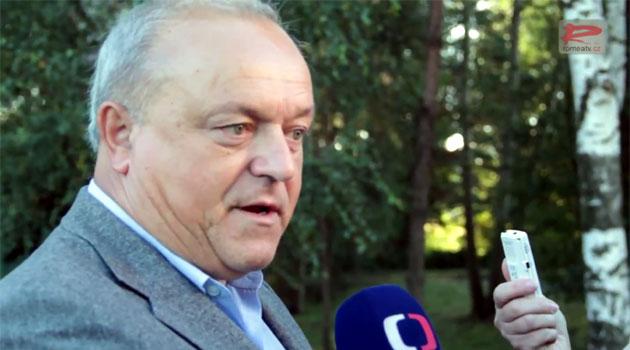International Holocaust Remembrance Alliance met with Czech Government about removing the pig farm at Lety concentration camp site

On 12 July an International Holocaust Remembrance Alliance (IHRA) delegation including the IHRA Chair, Ambassador Mihnea Constantinescu, attended high level meetings in the Czech Republic to discuss the future of the former concentration camp site of Lety u Pisku where a pig farm currently stands. Martina Maschke, Chair of the IHRA Committee on the Genocide of the Roma and Mirjam Karoly, ODIHR’s Senior Adviser on Roma and Sinti Issues formed part of the delegation and reflect below on their visit to the site. News server Romea.cz is publishing here the report they first released in August on the IHRA website.
Pig farming on the site of the former concentration camp for Roma. The disturbing case of Lety u Písku, Czech Republic.
Mirovice is a small town close to the village of Lety in South Bohemia. The gently rolling landscape that surrounds us on our way from Prague reminds us of the proverbial locus amoenus, the peaceful town square of Mirovice reflecting the faded glory of the Austro-Hungarian Empire. Yet Mirovice and Lety share a dark secret which unveils itself only if you talk to locals who speak up, seeking justice for their communities. Čeněk Růžička, Czech Sinto and the son of a survivor, is one of them. In the small, peaceful cemetery of Mirovice he leads us to a row of little teddy bears sitting next to the exterior wall. The place shelters the bodies of dozens of Roma children. On the opposite side, in another mass grave, rest the mortal remains of adults.
Čeněk Růžička lights candles and tells us in a soft voice about the fate of the men, women and children. Most of them died in the early 1940s from malnutrition, typhus and exhaustion in the so-called “Gypsy camp”, Lety u Písku, a forced labour camp 5 km from Mirovice. Only few survived. One of them was his mother. It was a miracle, he says. We listen in silence and look at the teddy bears which have never been in the hands of those children, to comfort them.
Čeněk tells us of his struggle to ensure dignified remembrance on the victims of the former forced labour camp Lety u Písku. There are still many missing facts and little awareness about this dark history among the general public in the Czech Republic. Only a very small number of the pre-war Roma population survived and of those, only few remained to give evidence.
We travel on to Lety. Approaching the memorial site, we are suddenly confronted with the overpowering smell of ammoniac as we pass by an industrial pig farm. We are told that the farm was established in the early 1970s on the exact site of the former concentration camp and its mass grave. The disturbing smell of the pig farm also follows us when we visit the nearby memorial site. Čeněk Růžička walks us around the memorial. It is an important symbol for the recognition of killings and persecution of Roma during World War II. The construction of the memorial which was unveiled by Václav Havel in 1995 is partly a result of Cenek Ruzicka’s tireless efforts to make the history and persecution of his community known to a wider public. But his decade-long fight for the dignified commemoration of the camp’s victims has not yet ended. Before we leave, he implores us to help find a solution for the removal of the pigs.
Appalled by the situation on the ground and haunted by the cynical smell of the farm, we climb into the bus and return to Prague where we have meetings with the two responsible Ministers, Jiří Dienstbier (Minister for Human Rights) and Daniel Herman (Minister for Culture). The IHRA Chair, Ambassador Contantinescu, who was part of the IHRA delegation on the site visit, expressed deep concern about the state of affairs and urged the Czech authorities to ensure that immediate steps were taken to initiate the removal of the pig farm. He stressed that this was the second IHRA visit to the site and that it was necessary for there to be concrete signals of change underway before the end of the current IHRA Romania Chairmanship in March 2017. He also underlined the readiness of IHRA to support the Czech Republic in finding a solution. The aim of our visit was to make the strong point to the Czech authorities that the IHRA, the foremost international network of political leaders and professionals on Holocaust-related issues, will not accept the continuing desecration of the dignity of the Roma victims of Lety.
The so-called “Gypsy camp” at Lety was established on August 2, 1942 by the Reichsprotektorat Böhmen und Mähren in order to isolate “Gypsies” and “gypsy half-breeds” from the rest of society. The labour camp was in operation until 4 May 1943. In the 9 months of its operation, approximately 1400 prisoners passed through the camp. 362 people died in the camp directly, 540 people died during mass transports to Auschwitz, and a total of 513 victims were gassed.
IHRA’s Committee on the Genocide of the Roma has been examining the situation of memorial sites connected to the genocide of the Roma that are in urgent need of improvement since 2014. This visit to Lety follows an earlier visit which took place in March 2015. In 2015, the Czech government adopted the Roma Integration Strategy 2020 which also sets the objective of finding a solution for the removal of the pig farm. In line with this commitment, Minister Dienstbier and Minister Herman have held meetings with the representatives of the pig farm owners, but there is yet to be any visible progress.
There have been a number of international calls for removal of the pig farm including EU resolutions of 28 April 2005 and 31 January 2008, Council of Europe Human Rights report of 11 March 2011, and the UN Human Rights Committee of 25 July 2013.
Lety is not an isolated case. While it is not precisely known how many endangered Holocaust-related sites there are, the International Holocaust Remembrance Alliance has particular concerns about a number of sites throughout its Member Countries and Observer Countries. Already in 2007 IHRA Member Countries adopted a resolution recognizing the extraordinary importance of researching and marking for posterity the physical locations where Holocaust-related events occurred, agreeing to undertake all possible measures to mark such sites, preserve them, and prevent their misuse. The current IHRA Chair has made it a key focus of his chairmanship to ensure that this recommendation is translated into political action.
The composition of IHRA means it is uniquely placed to take the lead on and progress issues related to endangered sites. The IHRA brings together both political leaders and professionals: experts raise concerns about sites with the IHRA Plenary and the Plenary can take stock of endangered sites, organize conferences and publications on lesser known sites, intervene politically on a governmental level and, importantly, support Member Countries with the actual preservation and marking of endangered sites. The International Holocaust Remembrance Alliance is an intergovernmental organization whose purpose is to place political and social leaders’ support behind the need for Holocaust education, remembrance and research both nationally and internationally. Its 31 member countries are committed to the tenets of the Stockholm Declaration. Endangered sites, such as Lety are a strong focus of IHRA’s content and political work.
Martina Maschke is Head of Department for Bilateral International Affairs and Holocaust Education at the Austrian Ministry of Education. She is member of the Austrian delegation to the IHRA and is currently chairing the IHRA Committee on the Genocide of the Roma.
Mirjam Karoly is the Chief of the Contact Point on Roma and Sinti of the OSCE’s Office for Democratic Institutions and Human Rights. ODHIR is one of IHRA’s seven permanent international partner organizations.
